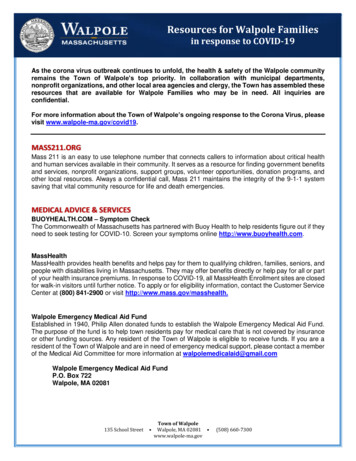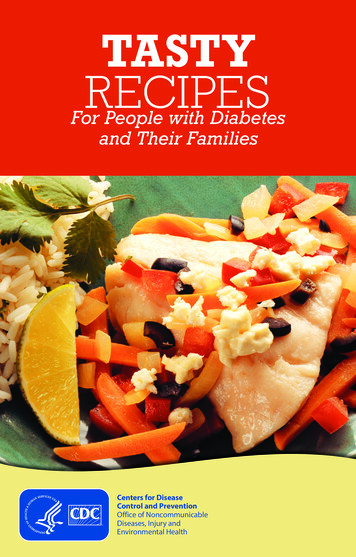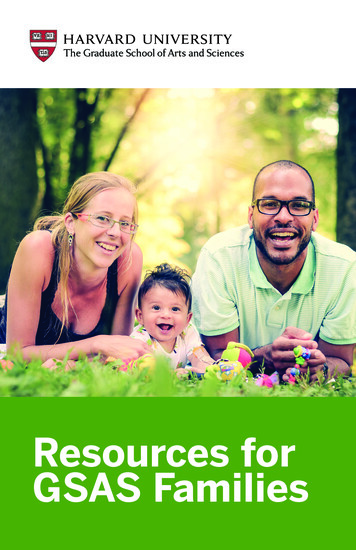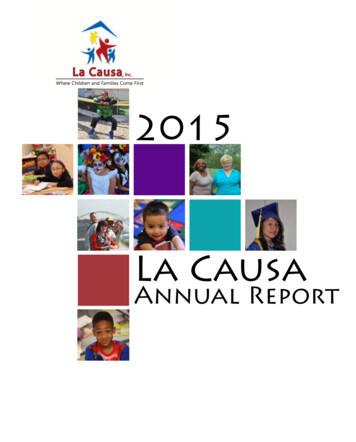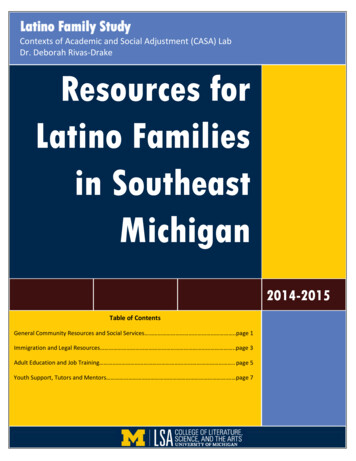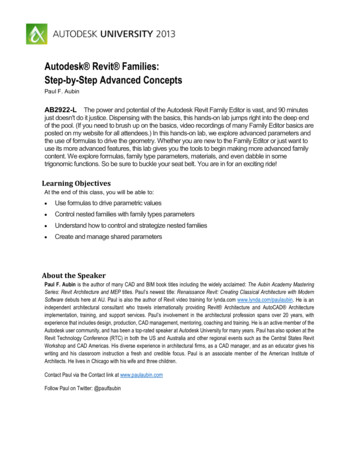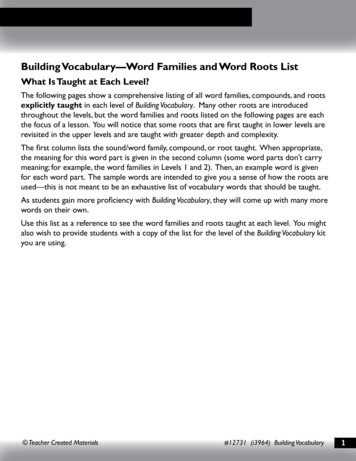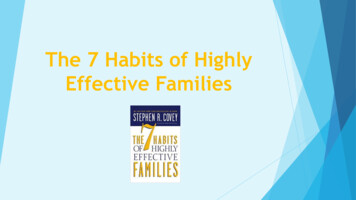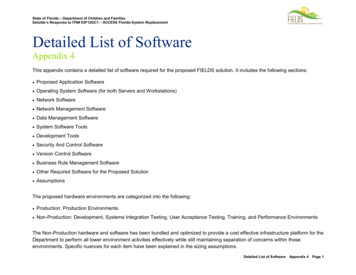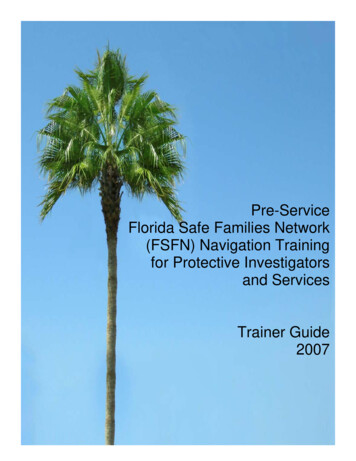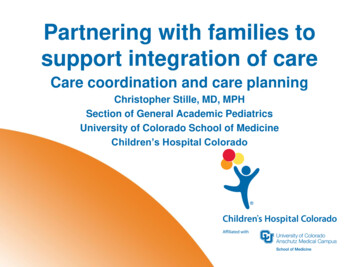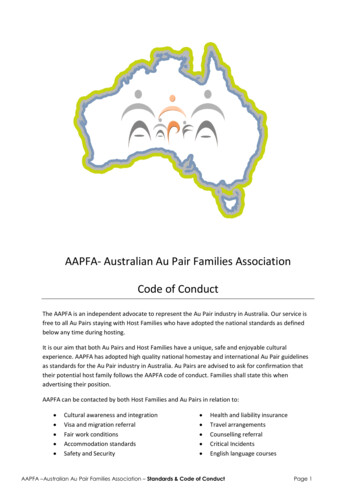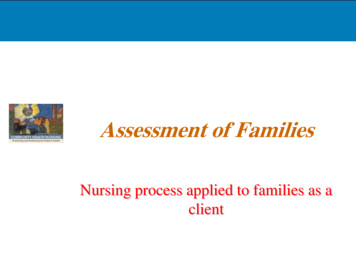
Transcription
Assessment of FamiliesNursing process applied to families as aclient
IntroductionChapter 22 explored the theoretical basis of familyformation and the variety of family structures.The next important step in the process of working withfamilies as a unit of service is to develop familyassessment Skills.Assessment is a challenging experience becauseFamilies are complex.assessment takes place in the family’s environment.( Where members feel ―at home‖ and the nurse may feel likea stranger).
Cont The problem derives in part from a health care system thatfosters individualistic orientation.Family-level problem-solving techniques are needed todeal with many important health issues. including healthpromotion, pregnancy and childbirth, etc.Ex, Thalasemic patientsCHNs need to focus their practices on families andaggregates, an approach that benefits both individualclients and the community at large.
Effects of Family Health on theIndividual:Adherence to cultural and family patterns ofeating, exercise, and communication.Decisions about health services.Family health patterns also dictate whethermembers participate in their own health care,follow through, and comply with professionaladvice.Ex, Mother who her husband have stroke.
Effects of Family Health on theCommunity:Positive influences:Foster parenting.Assistance with housing and employment for refugees.Community organizations for safety and beautificationof neighborhoods.Involvement in church, scouting programs, or variouscivic activities, such as parent-teacher-studentassociations.5MZC
Effects of Family Health on theCommunity:Negative influences:Noisy children, barking dogsLittered and garbage laden environments attract ratsGuns in the hands of childrenAbandoned appliances death traps for childrenSubstance abuseChild and spouse abuse 2005 by Lippincott Williams& Wilkins6MZC
Characteristics of a Healthy Family1.A facilitative process of interaction exists among familymembers.2.Individual member development is enhanced.3.Role relationships are structured effectively.4.Active attempts are made to cope with problems.5.There is a healthy home environment and lifestyle.6.Regular links with the broader community areestablished.7MZC
1. Healthy Interaction AmongMembers:Healthy families communicate. Their patterns ofinteraction are regular, varied, and supportive.Healthy families use frequent verbal & non-verbalcommunication.The family that has learned to communicate effectively hasmembers who are sensitive to one another.
Cont Effective communication is necessary for a family to carryout basic functions.Healthy families are more likely than unhealthy families tonegotiate topics for discussion, use humor, show respectfor differences of opinion, and clarify the meaning of oneanother’s communications.
2. Enhancement of IndividualDevelopment:Healthy families are responsive to the needs of individualmembers and provide the freedom and support necessaryto promote each member’s growth.Ex: father loses his job.The healthy family recognizes and fosters the growingchild’s need for independence by increasing opportunitiesfor the child to try new things alone.
Cont Within an appropriate framework of stability and structure,the healthy family encourages freedom and autonomy forits members.The result is an increase in competence:(self-reliance, social skills, intellectual growth, and overallcapacity for self-management among family members)
3. Effective Structuring ofRelationships:Healthy families structure role relationships to meetchanging family needs over time.In a stable social context, some families establish memberroles and tasks (e.g., breadwinner, primary decision-maker,homemaker).Changing life cycle stages require alterations in thestructure of relationships.
4. Active Coping Effort:Healthy families actively attempt to overcome life’sproblems and issues.Coping skills are needed to deal with emotional tragediessuch as substance abuse problems, serious illness, or death.The healthy family recognizes the need for assistance,accepts help, and pursues opportunities to eliminate ordecrease the stressors that affect it.
Cont More frequently, healthy families cope with less dramatic,day-to-day changes, ex. (increased cost of food).Healthy families are open to innovation, support newideas, and find ways to solve problems, ex. (solve theproblem of spending too much on transportation).Healthy coping may go beyond finding a simple, obvioussolution.Healthy families actively seek and use a variety ofresources to solve problems.
5. Healthy Environment and Lifestyle:Healthy families create safe and hygienic living conditionsfor their members.A healthy home environment is one that is clean andreduces the spread of disease causing organisms.A healthy family lifestyle encourages appropriate balancein the lives of its members.
Cont The emotional climate of a healthy family ispositive and supportive of growth.A healthy family demonstrates caring, encouragesand accepts expression of feelings, and respectsdivergent ideas.
6. Regular Links With the BroaderCommunity:Healthy families maintain dynamic ties with the broadercommunity. They participate regularly in external groupsand activities, often in a leadership capacity.They use external resources suited to family needs.Healthy families also know what is going on in the worldaround them.It is important for the CHNs to assess the family’srelationship with the broader community.
Cont An unhealthy family has not recognized the value ofestablishing links with the broader community. Thismay be because of:(1) a knowledge deficit regarding communityresources.(2) previous negative experiences with communityServices.(3) a lack of connection with the community becauseof family expectations or cultural practices.
Family Health Practice Guidelines:Family nursing is a kind of nursing practice in which the familyis the unit of service.Family nursing asks how one provides health care to a collectionof people. It does not mean that nursing must relinquish serviceto individuals.
Family Health Practice Guidelines:1-Work with the family collectively:Focus on individuals and remind themselves that severalpeople together have a collective personality, collectiveinterests, and a collective set of needs.Like a coach, the nurse wants to help family memberswork together as a team for their collective benefit. 2005 by Lippincott Williams& Wilkins20MZC
2. Start Where the Family Is.To discover where a family is, the community healthnurse:First: conducts a family assessment to ascertain themembers’ needs and level of healthSecond: determines collective interests, concerns, andpriorities.
3. Adapt Nursing Intervention to theFamily’s Stage of Development.Every family engages in the same basic functions, the tasksnecessary to accomplish these functions vary with eachstage of the family’s development.Ex, working with young family, teenage children, olderadultAwareness of the family’s developmental stage enables thenurse to assess the appropriateness of the family’s level offunctioning and to tailor intervention accordingly.
4. Recognize the Validity of FamilyStructural Variations.Such variations in structure and organizational patternshave resulted from social and technologic changesEx, employment practices, welfare programs, economicconditions, sex roles, status of women and minorities, birthcontrol, incidence of divorce, even war.Two important principles:First: what is normal for one family is not necessarilynormal for another.Second: families are constantly changing.
Cont:- The change in family life (predictable or not predictable).- The nurse’s responsibility is to help families cope with thechanges while remaining nonjudgmental and accepting ofthe various forms encountered.- Nurses should view all families as unique groups, eachwith its own set of needs, whose interests can best beserved through unbiased care.
5. Emphasize Family Strengths.Emphasizing a family’s strengths makes people feel betterabout themselves.It fosters a positive self-image, promotes self-confidence,and often helps the family address other problems.One helpful communication technique is strengthening.Verbally or in writing, the nurse lists positive points aboutan otherwise negative situation.
Cont.Assessment should explore all aspects of familyfunctioning to determine both strengths and weaknesses.Even as the nurse becomes more aware of a family’sunhealthy behaviors, the emphasis should remain on thepositive ones. Emphasizing strengths proves to the clients,in effect, that they are important to the nurse.Not all traits that appear positive are necessarily strengths.
FAMILY HEALTH ASSESSMENTTo assess a family’s level of health in a systematic fashion,three tools are needed:(1) a conceptual framework on which to base the assessment.(2) a clearly defined set of assessment categories for datacollection.(3) a method for measuring a family’s level of functioning.
Conceptual Frameworks.Is a set of concepts integrated into a meaningfulexplanation that helps one interpret human behavior orsituations.Three frameworks that are particularly useful incommunity health nursing are presented here:Interactional frameworksStructural-functional frameworksDevelopmental frameworks.
1- Interactional Framework:Describes the family as a unit of interacting personalitiesand emphasizes communication, roles, conflict, copingpatterns, and decision-making processes.Neglects interactions with the external environment 2005 by Lippincott Williams& Wilkins29MZC
2- Structural-functional Framework:Describes the family as a social system relating toother social systems in the external environment, suchas church, school, work, and the health care system.This framework examines the interacting functions ofsociety and the family, considers family structure,and analyzes how a family’s structure affects itsfunction.30MZC
3- Developmental Frameworks:Studies families from a life-cycle perspectiveby examining members’ changing roles andtasks in each progressive life-cycle stage ( mixbetween 1 & 2 ).Family structure, function, and interaction areviewed in the context of the environment ateach stage of family development.
Data Collection CategoriesCertain basic information is needed, however, to determinea family’s health status and to design appropriate nursinginterventions.From many sources in the family health literature, a list of12 data collection categories has been generated.Each grouped into one of three data sets:(1) Family strengths and self-care capabilities(2) Family stresses and problems(3) Family resources.
Cont 1. Family demographics:Refers to such descriptive variables as a family’scomposition, its socioeconomic status, and the ages,education, occupation, ethnicity, and religious affiliationsof members.2. Physical environment:Data describe the geography, climate, housing, space,social and political structures, food availability anddietary patterns, and any other elements in the internal orexternal physical environment that influence a family’shealth status.
Cont 3. Psychological and spiritual environment:Refers to affection relationships, mutual respect, support,promotion of members’ self-esteem and spiritual development,and life satisfaction and goals.4. Family structure and roles:Include family organization, socialization processes, divisionof labor, and allocation and use of authority and power.
Cont 5. Family functions:Refer to a family’s ability to carry out appropriatedevelopmental tasks and provide for members’ needs.6. Family values and beliefs:Influence all aspects of family life. Values and beliefsmight deal with raising children, making and spendingmoney, education, religion, work, health, and communityinvolvement.7. Family communication patterns:Include the frequency and quality of communicationwithin a family and between the family and itsenvironment.
Cont 8. Family decision-making patterns:Refer to how decisions are made in a family, by whomthey are made, and how they are implemented.9. Family problem-solving patterns:Describe how a family handles problems, who dealswith them, the flexibility of a family’s approach toproblem-solving, and the nature of solutions.10. Family coping patterns:Encompass how a family handles conflict and lifechanges, the nature and quality of family support systems,and family perceptions and responses to stressors.
Cont 11. Family health behavior:Refers to familial health history, current physicalhealth status of family members, family use of healthresources, and family health beliefs.12. Family social and cultural patterns:Comprise family discipline and limit-setting practices;promotion of initiative, creativity, and leadership; familygoal setting; family culture; cultural adaptations to presentcircumstances; and development of meaningfulrelationships within and outside the family.
Assessment MethodsMany different methods are used to assess families. Thesemethods serve to generate information about selectedaspects of family structure and function; the methods mustmatch the purpose for assessment.Three well-known graphic assessment tools are the:EcomapGenogramSocial network support map or grid.
The eco-mapA diagram of the connections between a family and theother systems in its ecologic environment. It was originallydevised to depict the complexity of the client’s story.Developed by Ann Hartman in 1975 to help child welfareworkers study family needs, the tool visually depictsdynamic family– environment interactions.The nurse involves family members in the map’sdevelopment. A central circle is drawn to represent thefamily, and smaller circles on the periphery representpeople and systems, such as school or work.
Eco-map:
The genogram:Displays family information graphicallyin a way that provides a quick view of complex familyp
FAMILY HEALTH ASSESSMENT To assess a family’s level of health in a systematic fashion, three tools are needed: (1) a conceptual framework on which to base the assessment. (2) a clearly defined set of assessment categories for data collection. (3) a method for measuring a family’s level of functioning.
